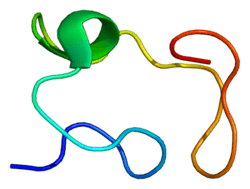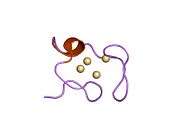Further reading
- Soumillion A, Van Damme J, De Ley M (1992). "Cloning and specific polymerised-chain-reaction amplification of a third charge-separable human metallothionein isoform". Eur. J. Biochem. 209 (3): 999–1004. doi:10.1111/j.1432-1033.1992.tb17374.x. PMID 1425708.
- Pauwels M, van Weyenbergh J, Soumillion A, et al. (1994). "Induction by zinc of specific metallothionein isoforms in human monocytes". Eur. J. Biochem. 220 (1): 105–10. doi:10.1111/j.1432-1033.1994.tb18603.x. PMID 8119276.
- Mididoddi S, McGuirt JP, Sens MA, et al. (1996). "Isoform-specific expression of metallothionein mRNA in the developing and adult human kidney". Toxicol. Lett. 85 (1): 17–27. doi:10.1016/0378-4274(96)03632-6. PMID 8619255.
- Vandeghinste N, Proost P, De Ley M (2000). "Metallothionein isoform gene expression in zinc-treated human peripheral blood lymphocytes". Cell. Mol. Biol. (Noisy-le-grand). 46 (2): 419–33. PMID 10774930.
- Nguyen A, Jing Z, Mahoney PS, et al. (2000). "In vivo gene expression profile analysis of metallothionein in renal cell carcinoma". Cancer Lett. 160 (2): 133–40. doi:10.1016/S0304-3835(00)00534-6. PMID 11053642.
- Rahman MT, Vandingenen A, De Ley M (2000). "Metallothionein biosynthesis in human RBC precursors". Cell. Physiol. Biochem. 10 (4): 237–42. doi:10.1159/000016355. PMID 11093034.
- Chen Y, Irie Y, Keung WM, Maret W (2002). "S-nitrosothiols react preferentially with zinc thiolate clusters of metallothionein III through transnitrosation". Biochemistry. 41 (26): 8360–7. doi:10.1021/bi020030. PMID 12081484.
- Strausberg RL, Feingold EA, Grouse LH, et al. (2003). "Generation and initial analysis of more than 15,000 full-length human and mouse cDNA sequences". Proc. Natl. Acad. Sci. U.S.A. 99 (26): 16899–903. doi:10.1073/pnas.242603899. PMC 139241. PMID 12477932.
- Izmailova E, Bertley FM, Huang Q, et al. (2003). "HIV-1 Tat reprograms immature dendritic cells to express chemoattractants for activated T cells and macrophages". Nat. Med. 9 (2): 191–7. doi:10.1038/nm822. PMID 12539042.
- Cui YP, Wang JB, Zhang XY, et al. (2003). "Using yeast two-hybrid system to identify ECRG2 associated proteins and their possible interactions with ECRG2 gene". World J. Gastroenterol. 9 (9): 1892–6. doi:10.3748/wjg.v9.i9.1892. PMID 12970870.
- Kroczynska B, Evangelista CM, Samant SS, et al. (2004). "The SANT2 Domain of the Murine Tumor Cell DnaJ-like Protein 1 Human Homologue Interacts with α1-Antichymotrypsin and Kinetically Interferes with Its Serpin Inhibitory Activity". J. Biol. Chem. 279 (12): 11432–43. doi:10.1074/jbc.M310903200. PMC 1553221. PMID 14668352.
- Gerhard DS, Wagner L, Feingold EA, et al. (2004). "The Status, Quality, and Expansion of the NIH Full-Length cDNA Project: The Mammalian Gene Collection (MGC)". Genome Res. 14 (10B): 2121–7. doi:10.1101/gr.2596504. PMC 528928. PMID 15489334.
- Sun NN, Fastje CD, Wong SS, et al. (2005). "Dose-dependent transcriptome changes by metal ores on a human acute lymphoblastic leukemia cell line". Toxicology and industrial health. 19 (7–10): 157–63. doi:10.1191/0748233703th185oa. PMID 15747776.
PDB gallery |
|---|
1mhu: THE THREE-DIMENSIONAL STRUCTURE OF HUMAN [113CD7] METALLOTHIONEIN-2 IN SOLUTION DETERMINED BY NUCLEAR MAGNETIC RESONANCE SPECTROSCOPY 1mrb: THREE-DIMENSIONAL STRUCTURE OF RABBIT LIVER CD7 METALLOTHIONEIN-2A IN AQUEOUS SOLUTION DETERMINED BY NUCLEAR MAGNETIC RESONANCE |




